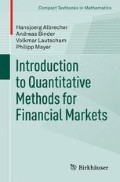Abstract
In Chapter 7 it has been shown that the Black-Scholes model allows to derive explicit formulas for the prices of European call and put options. Having explicit pricing formulas is a great advantage; however, the Black-Scholes model has also been found to not fully explain market prices due to some of its assumptions and properties.
Access this chapter
Tax calculation will be finalised at checkout
Purchases are for personal use only
Notes
- 1.
Data source: Yahoo Finance.
- 2.
The skewness coefficient \(\mathbb{E}\left [{\frac{{(X-\mu )}^{3}} {\sigma }^{3}} \right ]\) and the kurtosis \(\mathbb{E}\left [{\frac{{(X-\mu )}^{4}} {\sigma }^{4}} \right ]\) of a random variable X with mean μ and standard deviation σ are defined as the centralized and scaled 3rd and 4th moments, respectively.
- 3.
For example, plotting implied volatility against the strike price for options of the same maturity results in a ‘U’ shaped, ‘smiling’ curve, which is why this phenomenon is called volatility smile. The ‘smile’ is often fairly distorted in shape, as in Figure 8.2, so that the term volatility smirk has gained popularity. The ‘smiling’ shape is often more pronounced for FX options than for equity options.
- 4.
These assumptions can be relaxed to a certain extent. For a detailed discussion of stochastic differential equations, see Øksendal [60].
- 5.
Multi-dimensional Itô’s Lemma. Let \(\mathbf{X}_{t} = (X_{t,1},X_{t,2},...,X_{t,n})\) be an n-dimensional vector of Itô processes. For twice differentiable f it then follows that \(df(t,\mathbf{X}_{t}) = \frac{\partial f} {\partial t} \mathit{dt} +\sum _{ i=1}^{n} \frac{\partial f} {\partial X_{t,i}}dX_{t,i} + \frac{1} {2}\sum _{1\leq i,j\leq n} \frac{{\partial }^{2}} {\partial X_{t,i}\partial X_{t,j}}f \cdot dX_{t,i}dX_{t,j}.\)
- 6.
Note that \(\Lambda \) is the quotient of the Vegas of the two calls.
- 7.
This assumption has been much debated, but has the advantage that the resulting model remains analytically tractable.
- 8.
- 9.
The characteristic function \(\mathbb{E}({e}^{iuX})\) of a random variable X can give a very efficient way to describe the properties of the distribution of X. If X has the probability density function f X , then \(\mathbb{E}({e}^{iuX})\) can be interpreted as the Fourier transform of f X .
- 10.
The above is only one possible way of defining a Poisson process. The name is based on the fact that N t follows a Poisson distribution. This distribution was introduced by the French physicist and mathematician Siméon-Denis Poisson (1781–1840) in his 1837 work ‘Research on the Probability of Judgments in Criminal and Civil Matters’.
- 11.
Infinitely many derivatives would be required for hedging in the Merton model.
- 12.
There exist other risk-neutral measures which ‘fit’ the Merton model. Mostly, however, one would directly model the risk-neutral process according to (8.18).
References
R. Cont and P. Tankov. Financial Modelling with Jump Processes. Chapman & Hall/CRC, Boca Raton, FL, 2004.
E. Derman and I. Kani. Riding on a smile. RISK, 7(2):32–39, 1994.
B. Dupire. Pricing with a smile. RISK, 7(2):18–20, 1994.
J.-P. Fouque, G. Papanicolaou, and K. R. Sircar. Derivatives in Financial Markets with Stochastic Volatility. Cambridge University Press, Cambridge, 2000.
S. L. Heston. A closed-form solution for options with stochastic volatility with applications to bond and currency options. Review of Financial Studies, 6(2):327–343, 1993.
A. L. Lewis. Option Valuation under Stochastic Volatility. Finance Press, Newport Beach, CA, 2000.
B. Øksendal. Stochastic Differential Equations: An Introduction with Applications. 6th edition. Springer-Verlag, Berlin, 2010.
W. Schoutens. Lévy Processes in Finance. Wiley, New York, 2003.
Author information
Authors and Affiliations
Rights and permissions
Copyright information
© 2013 Springer Basel
About this chapter
Cite this chapter
Albrecher, H., Binder, A., Lautscham, V., Mayer, P. (2013). Stock-Price Models. In: Introduction to Quantitative Methods for Financial Markets. Compact Textbooks in Mathematics. Birkhäuser, Basel. https://doi.org/10.1007/978-3-0348-0519-3_8
Download citation
DOI: https://doi.org/10.1007/978-3-0348-0519-3_8
Published:
Publisher Name: Birkhäuser, Basel
Print ISBN: 978-3-0348-0518-6
Online ISBN: 978-3-0348-0519-3
eBook Packages: Mathematics and StatisticsMathematics and Statistics (R0)

